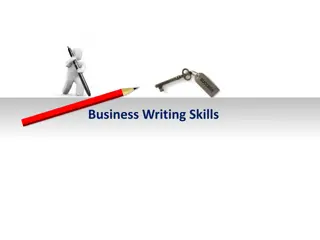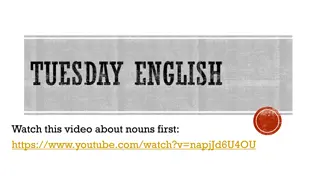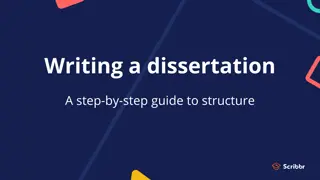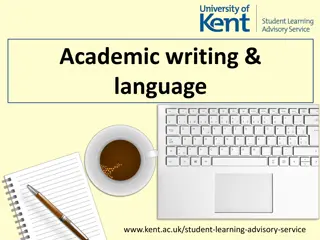Mastering Abstract Writing for Effective Research Communication
Learn the essential functions and parts of an abstract, including how to craft a clear and compelling abstract to attract readers to your full article. Explore tips on orienting readers, structuring content, and avoiding common pitfalls in abstract writing.
Download Presentation

Please find below an Image/Link to download the presentation.
The content on the website is provided AS IS for your information and personal use only. It may not be sold, licensed, or shared on other websites without obtaining consent from the author.If you encounter any issues during the download, it is possible that the publisher has removed the file from their server.
You are allowed to download the files provided on this website for personal or commercial use, subject to the condition that they are used lawfully. All files are the property of their respective owners.
The content on the website is provided AS IS for your information and personal use only. It may not be sold, licensed, or shared on other websites without obtaining consent from the author.
E N D
Presentation Transcript
Writing the Abstract and Acknowledgments 1. Writing an effective abstract Functions of an abstract Parts of an abstract 2. How should I write my acknowledgments?
Functions of an Abstract An abstract is a complete story in 250 words! It contains: Brief orientation to topic Your specific goal Strategy and methods used Central results & big conclusions
Functions of an Abstract Summarizes the major points The abstract; Is used as indexing tool Is available in electronic databases May be the ONLY part of your paper someone reads Attracts the reader to READ the rest of the article. You want them to read the full article ---> SO MAKE THE ABSTRACT CLEAR! 1. 2. 3.
The abstract is an argument It is not an introduction It is not a list It is not an unsolved mystery
Parts of Abstract Abstract = mini article! Introduction Why? Abstract Methods How? Results What? Significance? Discussion
Abstract Content May contain the same information as: The last paragraph of the introduction Your first paragraph of the discussion NEVER include information that is not presented elsewhere in article DO NOT include a reference citation in abstract
Orient Reader in the First Sentence The first sentence can be very general: FOR EXAMPLE In recent years, dengue viruses have spread throughout tropical regions worldwide.
State topic and purpose In this study, the prevalence of Malaria infection in Port au Prince, Haiti was determined. In order to characterize genetic variations, 83 strains of Mycobacterium tuberculosis from California were analyzed by restriction fragment polymorphism (RFLP).
Specify your methods-- briefly! Name the technique: - Too general: Biochemical studies showed that - Better: In vitro translation studies revealed that
Specify your methods-- briefly! Can often describe methods in introductory phrase Using RT-PCR, 384 samples were analyzed for the presence of poliovirus RNA. Using restriction fragment length polymorphism (RFLP) analysis, we characterized genetic variation among Mycobacterium tuberculosis strains.
Summarize Results & Conclusions Summarize the central results The most significant points only Remove needless information Identify the major conclusions Only space for your major conclusions
When stating the results, be definitive The prevalence of Dengue in children <10 years of age increased from 15% in 2001 to 22% in 2004. HAV RNA was detected in 10 of the 24 samples. BUT when interpretingresults use appropriate qualifiers: This indicates suggests may might could
Make EVERY word count! Often the abstract is 250 words Look at every word: do you need it? Save words by eliminating passive voice Read it out loud
Talk Outline 1. Writing an effective abstract Functions of an abstract Parts of an abstract 2. How should I write my acknowledgments? A. Who to include B. Who to omit C. How to acknowledge people D. How to acknowledge funding agencies
Who should you acknowledge? When in doubt: It s better to include too many people than to omit someone!
Include: Anyone who gave you technical help Anyone who gave you valuable input on your study design or interpretations of your results 1. 2. 3. Your human subjects 4. Anyone who gave you materials or supplies 5. Specify your funding sources Granting agency (include grant number) Fellowship funding Institutional funding
Do not acknowledge Co-authors
Examples: People We thank D. Flores for technical assistance. We thank S. Smith for valuable discussions and critical readingof the manuscript. We thank Bart Simpson for providing the dengue virus isolatesfrom Springfield. We thank Marge Simpson for her support.
Examples: People We also thank our collaborator Alberto Gianella at the Centro Nacional de Enfermedades Tropicales in Santa Cruz, Bolivia. Thanks to Dr. Luz Cruz for her kind gift of ECAD2 antibody. Thanks to Steve Opendoor for sharing results pre- publication.
Examples: Funding Financial support for this work was provided in part by the American Society for Biochemistry and Molecular Biology, the Fogarty International Center, and the National Institutes of Health (grant D43 TW00905). This study was also supported in part by a Centers for Disease Control and Prevention Post-Doctoral Fellowship awarded to B. Simpson.























